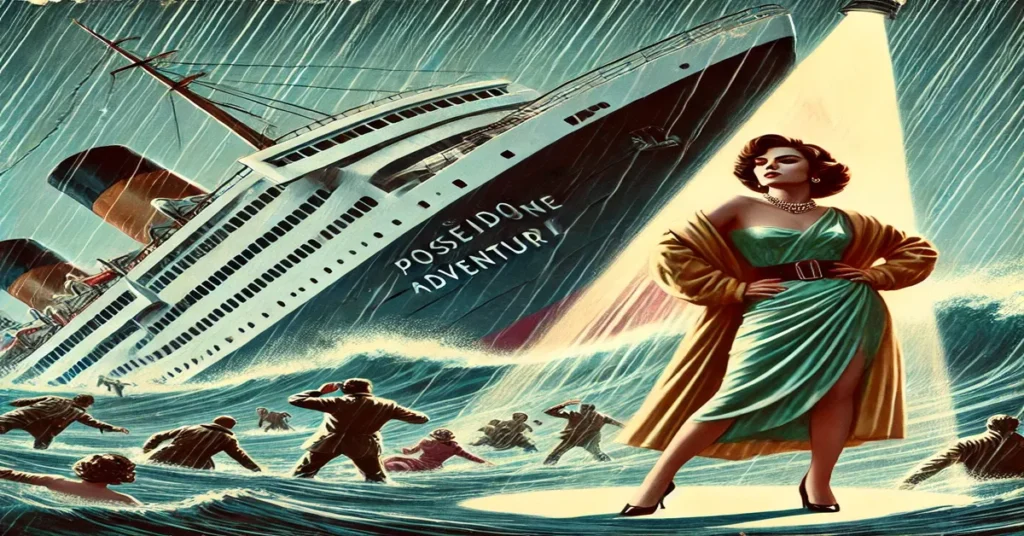Should Have Played The Prostitute In the Poseidon Adventure Article – In 1972, The Poseidon Adventure set the stage for one of the most memorable disaster films of the era. Directed by Ronald Neame and produced by Irwin Allen, the movie became a major box-office success, captivating audiences with its thrilling survival story. Among the ensemble cast, some of the most notable performances came from Gene Hackman, Shelley Winters, and Ernest Borgnine. However, what continues to generate conversation today, more than half a century later, is the role of Linda Rogo, played by Stella Stevens. Rogo’s character, a former prostitute with a fiery personality, brought a unique depth and complexity to the film.
Though Stevens did a remarkable job with her portrayal, the question remains: who else could have played the prostitute in The Poseidon Adventure? This article will explore the cultural impact of the character, the significance of the role, and the potential actresses from the time who could have taken on the role of Linda Rogo. By delving into these aspects, we aim to answer why the role was important and whether any other actress could have elevated or altered the performance and the film’s legacy.
1. The Role of Linda Rogo
1.1 A Complex Character
Should Have Played The Prostitute In the Poseidon Adventure Article – Linda Rogo, the character portrayed by Stella Stevens, is the wife of Mike Rogo (Ernest Borgnine), a former cop who has an abrasive yet protective attitude towards her. Their relationship is often tense, reflecting the complexities of Linda’s past life as a prostitute and Mike’s discomfort with it. Linda’s street-smarts, vulnerability, and outward bravado make her a compelling character who defies stereotypical expectations of women in disaster films of that time.
In many ways, the role of Linda Rogo was groundbreaking. While other female characters in disaster films (Should Have Played The Prostitute In the Poseidon Adventure Article) often fell into predictable roles of the damsel in distress, Linda was self-reliant, sharp-witted, and capable . She provided a different kind of strength that was necessary for survival in the chaotic, overturned ship. Her backstory as a former prostitute gave her an edge, as she was portrayed as a woman who had seen the harsher sides of life and could handle herself in extreme circumstances.
1.2 Casting Stella Stevens
Stella Stevens’ performance as Linda Rogo was widely praised. Stevens, a popular actress of the 1960s and early 1970s, was known for her comedic timing and her beauty, which made her a favorite in many films of that era (Should Have Played The Prostitute In the Poseidon Adventure Article). Her portrayal of Linda Rogo, however, took her into more serious dramatic territory. Her ability to convey both the toughness and the vulnerability of Linda made her character one of the most memorable in The Poseidon Adventure.
1.3 The Importance of the Prostitute Trope
The “prostitute with a heart of gold” is a recurring trope in cinema, often used to provide complexity to a female character who would otherwise be marginalized. Linda Rogo’s background as a former prostitute isn’t just a side note in the film; it is integral to her character arc (Should Have Played The Prostitute In the Poseidon Adventure Article). Her past provides depth to her relationship with Mike and shapes her actions throughout the film.
In the 1970s, sex workers were typically depicted either as victims or as women who were morally questionable. By contrast, Linda Rogo defied these clichés. She was independent, knew how to survive, and cared deeply for her husband, even if their relationship was far from perfect (Should Have Played The Prostitute In the Poseidon Adventure Article). Her past as a prostitute wasn’t a source of shame for her, but rather something that had toughened her up for the challenges she faced during the disaster. It’s this nuance in the character that continues to intrigue audiences and provoke discussions about the role and its casting (Should Have Played The Prostitute In the Poseidon Adventure Article).
2. Alternative Actresses: Who Else Could Have Played Linda Rogo?
While Stella Stevens did an excellent job, the question remains: who else could have taken on the role and provided a different dynamic to the character? Given the time period and the actresses working in Hollywood during the early 1970s, there were several strong contenders (Should Have Played The Prostitute In the Poseidon Adventure Article).
2.1 Faye Dunaway
Faye Dunaway was one of the most prominent actresses of the early 1970s, known for her powerful performances in films like Bonnie and Clyde (1967) and Chinatown (1974). Dunaway brought a certain intensity to her roles, and her portrayal of a former prostitute in The Poseidon Adventure might have emphasized the darker, more complex aspects of Linda’s character (Should Have Played The Prostitute In the Poseidon Adventure Article). With her talent for playing strong, multi-faceted women, Dunaway could have brought a gravitas to the role that might have shifted the character’s arc.
2.2 Jane Fonda
Jane Fonda, who was emerging as a serious actress around the time The Poseidon Adventure was filmed, could have also taken on the role of Linda Rogo. By the early 1970s, Fonda had shed her earlier image as a sex symbol and was taking on more challenging, politically charged roles, such as her Oscar-winning turn in Klute (1971). Fonda’s portrayal of a former prostitute would likely have leaned more into the feminist dimensions of the character, highlighting Linda’s independence and resilience (Should Have Played The Prostitute In the Poseidon Adventure Article).
2.3 Raquel Welch
Raquel Welch, another actress who was highly popular in the late 1960s and early 1970s, might have been a natural fit for the role of Linda Rogo. Welch, known for her roles in adventure and action films, had the physicality and the screen presence that could have made Linda Rogo a more physically commanding character (Should Have Played The Prostitute In the Poseidon Adventure Article). While Welch was often typecast in roles that emphasized her looks, her talent for conveying strength and determination could have made her portrayal of Linda memorable in its own way.
2.4 Diane Keaton
Diane Keaton, though not as well-established in 1972 as she would become later, could have offered a different take on Linda Rogo. Keaton’s quirky, offbeat acting style might have brought out a more vulnerable and introspective side of Linda. While Keaton may not have had the overt sex appeal that the character of Linda Rogo demanded, her ability to portray complex emotions could have provided a more nuanced interpretation of the character’s past as a prostitute – Should Have Played The Prostitute In the Poseidon Adventure Article.
3. Cultural Significance of the Role
3.1 Shifting Portrayals of Women in Film
The 1970s were a pivotal time for the portrayal of women in film. The feminist movement was gaining momentum, and Hollywood was beginning to reflect changing attitudes toward gender roles. The character of Linda Rogo can be seen as a reflection of these cultural shifts (Should Have Played The Prostitute In the Poseidon Adventure Article). While she was tough and independent, she was also deeply flawed, making her a more relatable and realistic character than many of the one-dimensional female roles in disaster films.
3.2 The Prostitute Archetype and Female Empowerment
The use of the prostitute archetype in film has long been a way to explore female empowerment and sexuality. In the case of Linda Rogo, her past as a prostitute is not something that defines her, but rather something that informs her survival instincts and her ability to navigate difficult situations. This portrayal was a departure from the more simplistic portrayals of sex workers in earlier films, where they were often cast as tragic figures or villains (Should Have Played The Prostitute In the Poseidon Adventure Article).
3.3 The Legacy of Linda Rogo
Linda Rogo’s character has had a lasting impact on how former prostitutes are portrayed in film. Instead of being a cautionary tale, Linda’s character arc is one of resilience and redemption. Her ability to survive the disaster, both physically and emotionally, demonstrates that her past does not limit her future (Should Have Played The Prostitute In the Poseidon Adventure Article). In this way, Linda Rogo became a more progressive representation of a woman who has lived a hard life but continues to fight for herself and those she loves.
4. Why the Casting of Linda Rogo Matters
The casting of Linda Rogo in The Poseidon Adventure was crucial to the film’s success. Stella Stevens brought a unique energy to the role that made Linda a memorable and sympathetic character (Should Have Played The Prostitute In the Poseidon Adventure Article). However, had another actress been cast, the role could have taken on a different tone. Whether it was Faye Dunaway’s intensity, Jane Fonda’s feminist undertones, Raquel Welch’s physicality, or Diane Keaton’s vulnerability, each actress could have brought something new to the role, altering the film’s dynamic and perhaps its cultural impact.
Ultimately, the casting of Linda Rogo matters because it speaks to the larger issue of how women are portrayed in film. The choice of actress can shape how the audience views the character, and by extension, how they view women who have lived outside the bounds of societal expectations (Should Have Played The Prostitute In the Poseidon Adventure Article).
Conclusion
The character of Linda Rogo in The Poseidon Adventure remains an important part of cinematic history, not just because of the disaster genre but because of what she represents. As a former prostitute who defies the typical victim trope, Linda is a complex and empowered figure (Should Have Played The Prostitute In the Poseidon Adventure Article). Stella Stevens’ portrayal was iconic, but imagining other actresses in the role opens up a fascinating conversation about how casting can influence the portrayal of character archetypes like the “prostitute with a heart of gold.”
Whether another actress could have done the role justice is ultimately speculative, but it underscores the importance of strong female characters in cinema (Should Have Played The Prostitute In the Poseidon Adventure Article). Linda Rogo, as she was played, continues to resonate with audiences and serves as an example of how women can be portrayed with depth, dignity, and strength—even in the most extreme circumstances (Should Have Played The Prostitute In the Poseidon Adventure Article).
FAQs
1. Why is Linda Rogo’s character important in The Poseidon Adventure?
Linda Rogo’s character is significant because she defies traditional gender roles in disaster films. Her past as a prostitute adds complexity to her character, making her tough, resourceful, and relatable in a male-dominated genre.
2. Who played Linda Rogo in The Poseidon Adventure?
Linda Rogo was portrayed by actress Stella Stevens, whose performance earned widespread praise for its balance of toughness and vulnerability.
3. Could any other actress have played the role of Linda Rogo?
While Stella Stevens did an excellent job, several actresses from the time, such as Faye Dunaway, Jane Fonda, and Raquel Welch, could have brought different nuances to the role.
4. What does the “prostitute with a heart of gold” trope mean?
This trope refers to female characters who are sex workers but possess redeeming qualities like kindness, compassion, and moral strength. It is often used to add complexity to a character who might otherwise be judged solely by their profession.
5. How does Linda Rogo’s character challenge stereotypes?
Linda Rogo challenges stereotypes by being a former prostitute who is neither a victim nor a villain. She is portrayed as a strong, independent woman capable of surviving extreme circumstances, defying the typical portrayal of sex workers in earlier films.
6. What impact did The Poseidon Adventure have on the disaster film genre?
The Poseidon Adventure helped popularize the disaster film genre, combining thrilling action with character-driven drama. Its success led to a wave of similar films in the 1970s and established the blueprint for ensemble-cast disaster movies.







